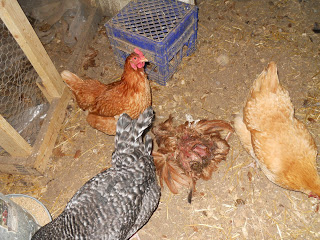

Cannibalism in poultry is simply one bird eating part or the whole of another bird as food. This is not pleasant and every farm must try to prevent this situation. Cannibalism in poultry is usually caused by one or more of these conditions:
Overcrowding
Large breeds of chickens should be allowed: 1/4 sq. ft./bird for first 2 weeks, 3/4 sq. ft./bird for 3-8 weeks, 1.5 sq. ft./bird from 8 to 16 weeks of age, 2 sq. ft./bird from 16 weeks on Bantam chickens require half the space as large chickens. With pheasants, allow 25 to 30 sq. ft./bird after 12 weeks of age or use pick prevention devices like plastic peepers or blinders.
Too much heat
When the birds become uncomfortably hot they can become extremely cannibalistic. Be sure to adjust the brooding temperature as the young fowl get older. Brood young fowl at 95°F. for the first week and then decrease the temperature 5°F. per week, until you reach 70°F. or the outside temperature. The temperature should be measured at the height of the birds back directly under the heat source. Do not heat the entire brooding facility to the recommended temperature. Not decreasing the brooding temperature is a common mistake that leads to problems like cannibalism.
Too much light
Extremely bright light or excessively long periods of light will cause birds to become hostile toward one another. Never use white light bulbs larger than 40 watts to brood fowl. If larger bulbs are required for heat, use red or infra-red bulbs. When raising birds 12 weeks of age or older, use 15 or 25 watt bulbs above feeding and watering areas. Never light fowl more than 16 hours per day. Constant light can be stressful to the birds.
Inadequate or no feed or water
If the birds have to fight for food and water, or if the birds are always hungry they will increase pecking. Be sure that birds have free access to water and feed at all times. The pecking order determines which birds get to eat and when. When you have inadequate feeder space birds at the lower end of the pecking order may never be allowed to eat.
Unbalanced diet
Extremely high energy and low fiber diets cause the birds to be extra active and aggressive. Feed lacking protein and other nutrients, particularly Methionine, will also cause birds to pick feathers. Make sure you feed a diet balanced appropriately for the age and types of fowl you are raising. Mixing of different types, sizes, and colors of fowl:
Mixing different ages and sizes of fowl or fowl with different traits promote pecking by disrupting the flock’s normal pecking order. Never brood different species of fowl together in the same pen. Don’t brood feathered leg fowl, crested fowl or bearded fowl with fowl without these traits. Curiosity can also start pecking. Toe pecking in the first few weeks is often started due to curiosity of the different colors or traits.
Sudden changes in environment or in management practices
If you plan to move young birds to a new location, it is best to move some of their feeders and waterers with them in order to help them adapt. When you change over to larger feeders and waterers it is helpful to leave the smaller equipment in the pen for a few days to help during the change.
Leaving crippled, dead or injured birds in the flock
Fowl will pick on crippled or dead birds in their pens because of the social order and curiosity. Once pecking starts it can quickly develop into a vicious habit.
Slow feathering birds
Take extra precautions with slow feathering birds. Most cannibalism occurs during father growth in young fowl. Birds with slow feathering have immature tender feathers exposed for longer periods of time leaving them open to damage from pecking. Don’t raise slow feathering birds with other fowl.
Introduction of new birds to the flock
Anytime you add or remove birds from a flock you disrupt the pecking order of the flock. It is best to introduce any new birds into your pen by splitting the pen with a wire wall for at least a week to help the birds to get to know each other. Also, adding the birds to the perch at night can help. Always supervise new introductions to the flock and intervene if the pecking gets out of control and birds are getting hurt. It may take a week or more for flock to re-establish the new pecking order.
Prolapse pecking
Prolapse can occur in very young or fat laying flocks. Prolapse is when the uterus stretches and tears and takes longer to properly return into the body cavity after the egg is laid. This is most common in young flocks that start laying too soon (prior to 20 weeks of age or in fat layers). When the uterus is exposed for a period of time other birds will see it and pick at it out of curiosity. Once they pick at the uterus it bleeds and the picking quick progresses to cannibalism. If you start seeing blood streaks on the shell surface your flock may be prone to prolapse. Properly managing how you bring your birds into production and proper feeding practices can prevent this problem. Fat birds will need to be put on a low energy diet.
 Contact Jaguza Support
Contact Jaguza Support